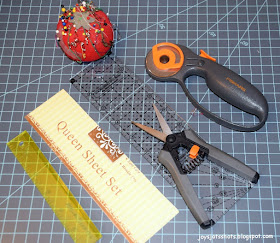"Tear" is a homonym with at least 2 meanings that could be used correctly in the title of this post.
I don't cry and have no tears using this process.
While I really enjoy paper piecing and the perfection it provides,
ripping out the paper plays havoc with my arthritic fingers.
I despise taking out the paper in the paper piecing process.
I found this video 3 or 4 years ago and was totally fascinated with Quilt N Bee's process.
First of all, since there is no stitching in the paper involved,
that step is basically skipped. Such a time saver.
Also, paper is saved. You can reused the pattern several times.
**************
I tried to do the process from memory.
Consequently, I've come up with a slightly different method than Quilt N Bee.
I downloaded their Woven Star pattern and printed 5 sheets of which I ended up using only 4.
You could just print 1 for a pattern to cut pieces ahead if you like to do that,
and only 1 more to make as many blocks as you can before it falls apart.
After I printed the pattern, I chose the 7 fabrics I needed
laying them in the order I would use them from center out.
Yellow was discarded and black will be used for the center.
Patterns were trimmed leaving the outer quarter inch allowance.
My basic tools I used besides sewing machine and thread
Then to make this whole process super successful and easy was my
Joining or Edge foot, whichever you like to call it.
Two tools used for this process that aren't normally used in piecing a quilt
is the Add-a-Quarter Ruler. Thank-you whoever thought of this idea!
The other is in your garbage; a straight piece of lightweight cardboard as in cereal box.
Here it's the piece of cardboard that came in a set of sheets serving as it's label.
It's cut to a size to be manageable leaving the straightedge uncut.
The lightweight cardboard is used to fold and crease the paper as straight as possible.
The straight edge is laid on the black lines and the paper is folded over the cardboard.
To start this process, each paper is folded on ALL the black lines.
Don't worry about folding over a previously folded line.
I did use my creaser (is that what you call them?) to create the folds on one sheet.
The completed block used 4 of these designs.
I experimented with the first, and when it was successful,
I then decided to do the remaining 3 in assembly line fashion.
Cut #1 using the section as a pattern being sure to add quarter inch seams all around.
Double pin so the piece won't shift.
*
For easy management, cut pieces of fabric 1¼ in wide or wider.
These coral pieces are measured long enough to provide sections #2 & #3.
Fold paper so #2 section is facing you.
Place fabric behind, right sides of fabrics together. (Right side of coral is facing you.)
Align the top edges and right edges of bother fabrics.
Above the piece is slightly flipped forward so you can see the backside.
Using the edging foot,
move needle to right just behind the blade but where it will not stitch into the paper.
Stitching will be beside the fold of the paper.
Wherever your stitches land be consistent throughout block.
After EACH stitching, fold back and trim all around where possible as done usually when paper piecing.
For this pattern, the routine becomes the following if you matched at the * to start stitching:
1. Cut across long edge
2. Cut across angle.
For the first time, you will use to cardboard to help fold.
Then use the Add-a-Quarter ruler to cut.
Then use the Add-a-Quarter ruler to cut.
Then fold back so #3 is facing you and repeat process until finished.
Small pins were used to hold the pieces in place as shown.
Be sure to push pins away from stitching line.
Meanwhile, the first one I made used very small dots of glue from a glue stick.
It torn the paper a bit and left residue on #1.
At this point, I go back and look at the Quilt N Bee video to see how they "stuck" the fabric to the paper.
The secret ingredient was freezer paper!
So I made one more block trying freezer paper.
However, I didn't stitch the paper or mark the end points.
Instead, I ironed my pattern sheet on the freezer paper,
folded the paper, and still ended up marking the sheet.
However, I didn't stitch the paper or mark the end points.
Instead, I ironed my pattern sheet on the freezer paper,
folded the paper, and still ended up marking the sheet.
I had to pin. The wax paper didn't hold the pieces well enough for me.
In the end, I still had to use about 3 pins.
So use whatever works best for you.
********
All I know is, I have no tears when I don't have to tear off the paper.
In the end, I still had to use about 3 pins.
So use whatever works best for you.
********
All I know is, I have no tears when I don't have to tear off the paper.
It takes me less than a minute to take out 3 or 7 pins.
Otherwise for a detailed piece like this,
it would take my hands about 10 minutes per block to tear away all the paper completely.
With the 5 blocks I made that would be an extra 50 minutes!
I'd also need 4 more sheets of paper!
Guess which piece of paper was creased with the creaser?
***
Possible quilts
to check the layout of your block.
************************************
Sharing at several Linky Parties including:
http://melsquiltingroom.blogspot.com/
http://www.blossomheartquilts.com/blog/
http://www.funkypolkadotgiraffe.net/
http://quiltstory.blogspot.com/
http://podunkpretties.blogspot.com
http://www.blossomheartquilts.com
http://melsquiltingroom.blogspot.com/
http://www.blossomheartquilts.com/blog/
http://www.funkypolkadotgiraffe.net/
http://quiltstory.blogspot.com/
http://podunkpretties.blogspot.com
http://www.blossomheartquilts.com






































This is brilliant! Thank you for such a detailed tutorial - excellent
ReplyDeleteI have used and liked the sewing beside the paper method before, but now I am anxious to try with the edge foot!!
ReplyDeleteIt's definitely a beautiful block. I had heard about this process, but never seen a tutorial on it. Thank you.
ReplyDeleteLove how this looks! I've done the freezer paper before, too, and yes - the 4th use is iffy. Depends on how well you iron it on (I tend to really press!).
ReplyDelete